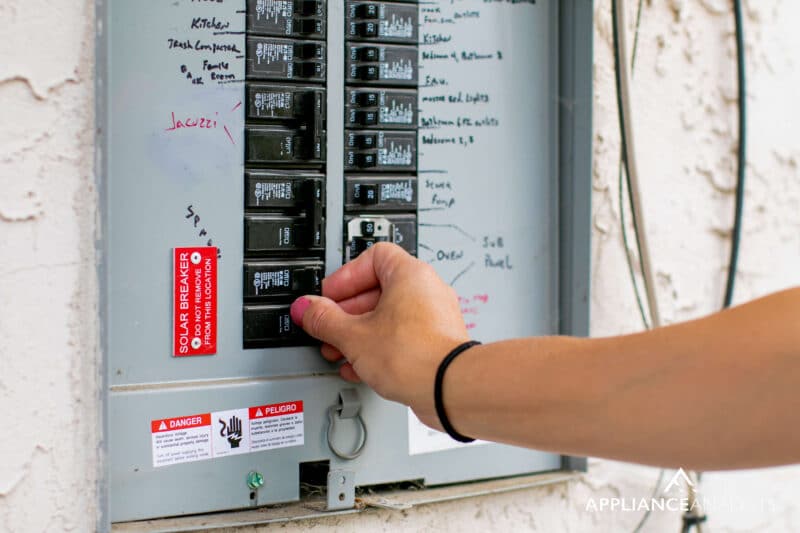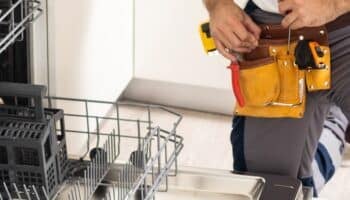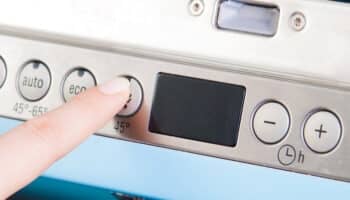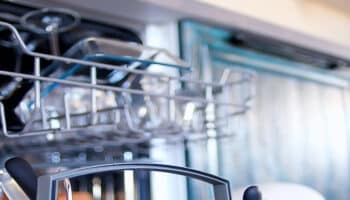Are you struggling to understand the error code on your dishwasher?
You’re not alone! I know how concerning it can be when your dishwasher displays an unfamiliar error code.
Don’t worry, though. This article covers the most common error codes across different dishwasher brands.
Dishwasher error codes can vary based on the brand. However, they generally indicate problems related to the water level, drainage, temperature, door, control board, or power. Most error codes can be cleared by resetting your dishwasher. If the issue persists, inspect the internal components.
Read on to clear your dishwasher’s error code!
Common Dishwasher Error Codes for 7 Brands Explained
In this section, I’ll guide you through the most common error codes for different dishwasher brands, such as GE, Whirlpool, KitchenAid, Bosch, Frigidaire, LG, and Samsung.
If you can’t find the error code displayed by your dishwasher in this guide, please refer to the manufacturer’s manual. It usually includes a troubleshooting section.
Keep in mind that in order to clear some dishwasher error codes, you’ll need to replace certain components. It’s crucial that you know your unit’s model number to ensure you find the correct replacement part.
Are you ready? Let’s dive in!
Common GE Error Codes
Like other brands, GE dishwashers will display an error code to help you identify and diagnose malfunctions.
The most common error codes on GE dishwashers are:
| Dishwasher Error Code | Meaning | How to Fix It |
| PF | It indicates that there was a power outage or a power issue. | Reset your dishwasher. Go to the circuit breaker and flip the switch for the dishwasher to the “Off” position. Then, wait for a couple of minutes, and switch it back to the “On” position. Once you’ve completed the steps above, turn on your dishwasher and select a cycle. |
| C1, C2, and C3 | The C1, C2, and C3 error codes indicate that your dishwasher took longer than usual to drain the water or that it’s not draining. | Check for drainage issues. My usual advice is to clean the dishwasher’s filter and ensure the drain hose isn’t kinked, clogged, or damaged. If your dishwasher is connected to your garbage disposal, run the disposal to clear any blockages. Don’t forget to remove any obstructions from the drain pump and replace it if necessary. Once you’ve completed the steps above, reset your dishwasher to clear the error code. |
| C4 | It indicates that your dishwasher filled with water twice due to a power failure. | Reset your dishwasher and tap on the float cover. Dishwashers have a float switch that detects the water level. Tap the plastic lid that covers the float switch to make sure it moves freely again. Then, check the sump area for debris. If the issue persists, please replace the float switch. |
| C5 | It suggests the dishwasher was not filled correctly due to a short pump-out time. | Check the water supply and float switch. Ensure the water supply valve is open. If it is, locate the float and move it up and down to see if it moves freely. If it doesn’t, remove any obstructions or replace it. |
| C6 | The water temperature is too low. | Run the kitchen tap until the water becomes hot. Check the heating element, thermostat, and control board if the issue persists. Replace any components if necessary. |

If you couldn’t find your dishwasher’s error code in the table above, access GE’s support page and download the manual by clicking here
Understanding Bosch Dishwasher Codes
Bosch is one of the best dishwasher brands due to their quiet operation and simple interface. However, even the best models can malfunction.
These are the most common error codes in Bosch dishwashers:
| Dishwasher Error Code | Meaning | How to Fix It |
| E01 | It indicates an issue with the circuit that powers the heat pump motor. | Restart your dishwasher by turning it off at the circuit breaker and then back on. Then, inspect the wires connecting the heat pump to the control board. If they’re damaged or burnt, please repair the connection. You can also test the heat pump motor with a multimeter. If you’re not getting the recommended readings from the manufacturer, the motor is probably faulty. |
| E02 and E03 | They point toward an error on the main control board. | Restart your dishwasher and inspect the control board, which is responsible for coordinating different functions. Look for any signs of damage or blown components. If there’s an issue with the control board, consider replacing it. Just keep in mind that the control board can be expensive. Sometimes, purchasing a new dishwasher is more cost-effective. |
| E06 | There’s a problem with the door sensor. | Check the door latch. Sometimes, a damaged or dirty door latch can cause the sensor not to detect the door is closed. You can also inspect the wires leading from the door sensor to the main control board. If damaged or frayed, please repair or replace them. Then, test the door sensor with a multimeter. If it doesn’t show continuity, replace it with a new one. |
| E12 | It indicates limescale build-up. | Clean your dishwasher. Limescale can accumulate due to hard water and affect your Bosch dishwasher’s cleaning performance. To clear the E12 error code, fill a cup with regular vinegar up to 1/4 of its capacity and place it on the top rack. As your dishwasher fills with water, the cup will slowly release the vinegar, which will help remove any buildup and keep your dishwasher clean. You can also use a commercial dishwasher cleaning solution. To prevent limescale, I recommend adding two teaspoons of table salt to the soap dispenser before adding the soap. |
| E22 | The filter is blocked. | Clean the filter. Your dishwasher’s filter can easily become clogged and cause drainage issues. To clear the E22 error code, clean the filter with warm soapy water and a wire or hard nylon brush. |
If you’re struggling with a different error code, please click here to access Bosch’s support page and download your dishwasher’s manual.
Frequent Whirlpool & KitchenAid Error Messages
While Whirlpool and KitchenAid dishwashers are known for their durability, understanding their error codes can sometimes be a bit challenging.
Let’s explore the meanings behind Whirlpool and KitchenAid dishwasher error codes:
| Dishwasher Error Code | Meaning | How to Fix It |
| F1 E1 | It indicates that your dishwasher is having trouble operating the fill valve correctly. As a result, the unit can’t continue with the washing cycle, and it will begin a drain sequence to prevent potential flooding. | Press Cancel and turn off the water supply. Then, turn your dishwasher off. Note: If you couldn’t turn off the water supply, keep your dishwasher powered and wait until the drain sequence is complete. Inspect the water supply. Make sure there are no kinks, and check the fill valve for any visible damage or obstructions. Replace any components if necessary. Reset your dishwasher to clear the error code. |
| H2O | There’s no water inside your dishwasher. As a result, the washing cycle will pause. | Make sure your dishwasher is connected to the water supply. It’s also important to straighten the water hose or replace it if it’s damaged. Move the float switch up and down to see if it’s stuck, and test the water inlet valve with a multimeter. If needed, replace any components. Then reset your Whirlpool or KitchenAid dishwasher. |
| F8 E4 | Your dishwasher is overfilling or leaking. As a result, a drain cycle will begin, and further operation will be prevented. Excessive suds can also cause the error code. | Move the float switch up and down and replace it if it’s faulty. Don’t forget to examine the connected hoses for any signs of leaking. Then, test the water inlet valve. The easiest way to do so is by starting a wash cycle and opening the door in the middle of the cycle. If water continues to fill in your dishwasher even when the door is open, please replace the water valve. It’s also crucial to use the recommended amount and type of detergent to prevent excessive suds. |
| F9 E1 | It indicates drainage issues. | Clean your dishwasher’s filter, run your garbage disposal, and check the drain hose. When checking the hose, clear any blockages and look for signs of damage, such as kinks. Replace it if necessary. It’s also important to examine the drain pump and clear any obstructions. |
| F6 E1 | There’s a communication error between the user interface and the main control board. | Reset your Whirlpool dishwasher by turning it off at the circuit breaker, waiting for a few minutes, and then turning it back on. Performing a reset will clear any software glitches. If the error message persists, check the wiring. Keep in mind that if the control board is malfunctioning, it’s often best to replace the entire unit. |

Note: If your Whirlpool dishwasher’s lights are blinking and you’re not seeing an error code, you can find out the meaning of the blinking pattern by clicking here.
Click the following links to download your dishwasher’s manual from the brand’s support page:
Troubleshooting Frigidaire Dishwasher Error Codes
Is your Frigidaire dishwasher displaying an error, but you’re not sure what it means? I’ve got you covered!
The following table will guide you in troubleshooting the most common error codes:
| Dishwasher Error Code | Meaning | How to Fix It |
| E10 /(or i10) | Your dishwasher is not receiving enough water during its fill cycle. | Ensure the water supply valve is fully open and check the hose. If it’s kinked, please straighten it out. But if it’s broken, you’ll need to replace it with a new one. The water inlet valve controls the flow of water into your dishwasher. If it’s faulty, the E10 or i10 error code will be displayed. Check the water inlet valve for any signs of damage or test it with a multimeter. Replace it if necessary. |
| E20,E40, EF0 (or i20, i40, iF0) | There’s a drainage issue. | Clean your dishwasher’s filter. Use warm soapy water or vinegar and gently scrub away any debris. It’s also important to clean the sump area with a sponge or cloth. Examine the drain hose for any kinks or blockages. Don’t forget to inspect the drain pump as well. If your dishwasher is connected to the garbage disposal, make sure the knockout plug in the disposal has been removed to allow proper drainage. |
| E30 or i30 | Your dishwasher is overflowing with water or leaking in the bottom pan. | Inspect the seals and hoses. Look for any visible signs of damage. It’s also important to check the water inlet valve and float switch, as they control the water flow and level. If you notice they’re damaged, please get a replacement. I also recommend making sure your dishwasher is not leaning forward to prevent leaks. You can use a spirit level to ensure the unit is level. |
| E60 or i60 | It indicates your dishwasher is having trouble reaching the necessary water temperature. | Reset your dishwasher to see if the error code gets solved. If the issue persists, please test the thermostat with a multimeter. The thermostat is responsible for monitoring the water temperature and sending signals to the heating element. If it doesn’t show continuity, please replace it. It’s also important to test the heating element. You should get a reading between 4 and 14 ohms, but please verify with the manufacturer’s manual. If the multimeter shows a different reading, the heating element needs to be replaced. |
| EC0 or iC0 | There’s an issue with the electronic control system. | Reset your Frigidaire dishwasher by unplugging it from the wall outlet, waiting for a few minutes, and plugging it back in. If you can’t move your dishwasher, turn it off at the circuit breaker. If the error code persists, inspect the control board and wiring. In case a replacement is needed, I find it best to call a professional Keep in mind that replacing the control board is expensive. Sometimes, it’s more cost-effective to get a new dishwasher. |

If you couldn’t find your dishwasher’s error code in the table above, don’t worry! Click here to access and download your specific manual from Frigidaire’s Support page.
Interpreting LG Dishwasher Error Codes
Understanding the error codes displayed on your LG dishwasher is crucial to fixing any issues that keep it from working as it should.
The most common LG dishwasher error codes are:
| Dishwasher Error Code | Meaning | How to Fix It |
| AE or E1 | It indicates that your dishwasher is leaking. | Turn off your dishwasher and inspect the door gasket. If it’s worn or damaged, please replace it (new seals cost $10-$20 and are very easy to replace). Make sure your dishwasher is not leaning forward. Use a spirit level and adjust the appliance’s feet until the bubble is centered. Don’t forget to replace the spray arms if they’re cracked or damaged. It’s also important to examine the actuator, test the water inlet valve, and check if the float switch is moving freely. Replace any components if needed. |
| IE | Your dishwasher is filling with water slowly or not at all. | Make sure the water supply valve is turned on and check the supply hose. Ensure it’s not kinked and replace it if needed. You’ll also need to examine the water inlet valve and float assembly. If they’re faulty, your dishwasher won’t fill with water. Additionally, improper installation of the drain hose can cause premature draining and lead to the IE error code. Please refer to the owner’s manual to install the drain hose correctly. |
| PF | It indicates that your dishwasher had a power supply interruption. | Reset your LG dishwasher by turning it off at the circuit breaker, waiting for a few minutes, and switching its breaker to the “On” position again. To prevent the PF error from recurring, avoid using extension cords and make sure your dishwasher is on a dedicated circuit breaker. |
| HE | Your dishwasher is having difficulty reaching the desired water temperature. | Reset your dishwasher and start a new cycle to clear the error code. If the issue persists, test the heating element with a multimeter. If you don’t get a reading between 4 and 14 ohms (or the one recommended by the manufacturer), please replace the heater (it typically costs $20 to $50). Don’t forget to test the thermostat for continuity and check the electrical wiring. Replace any components as needed. |
| OE | It indicates a drainage issue. | Clean your dishwasher’s filter with a wire or stiff nylon brush. Don’t forget to clean the sump area as well. I also recommend checking the drain pump and straightening the drain hose. Get a replacement if it’s damaged. It’s also important to remove the air gap cover and look if there’s any blockage. If needed, clean the air gap with a long, flexible brush. |
Are you struggling with a different error code? Click here to access LG’s support page and download your manual.
Breaking Down Samsung Dishwasher Error Codes
Samsung is one of the top-rated dishwasher brands on the market. Unfortunately, even the most reliable appliances can run into issues.
Let’s take a look at what the error codes on your Samsung dishwasher indicate:
| Dishwasher Error Code | Meaning | How to Fix It |
| IE | It indicates your dishwasher’s filter is clogged. | Clean the filter with warm soapy water to ensure your dishwasher’s efficiency. Scrub the inside and outside of the filter with a wire brush. Then, rinse the filter and clean the sump area. If you use your dishwasher multiple times a week, I recommend checking and cleaning the filter at least once a month to prevent drainage issues. |
| CE | There’s a communication error between the control panel and the rest of your dishwasher’s components. | Reset your Samsung dishwasher. To do so, turn it off at the circuit breaker, wait for a few minutes, and turn it back on. If the CE error persists, please unplug the unit, access the circuit board, and check the wiring. Look for any loose connections or signs of damage like frayed wiring. |
| 9E | It indicates that there’s not enough water in your dishwasher. | Make sure the water supply valve is fully open and that there are no kinks or obstructions in the water hose. If necessary, replace the hose. Now, you’ll need to check the water inlet valve, which is responsible for controlling the flow of water. Please clean it, and if the issue persists, replace it. Don’t forget to make sure the float moves freely. If it’s faulty, get a replacement. |
| SC and SE | There’s a drainage issue. | Straighten the drain hose, remove any obstructions, and replace it if necessary. If the drain hose is not the culprit behind the drainage issue and your filter is clean, run your garbage disposal and ensure you’ve removed the knockout plug. It’s also important to make sure the drain pump is not obstructed. Replace it if necessary. |
| bE or 6E | A button on the control panel is stuck. | When fixing a bE error code, I always unplug the dishwasher and gently press and release every button on the control panel. Sometimes, gunk can build up around the button, causing it to stick. So, it’s also important to use a damp cloth to clean around the buttons. |
If your dishwasher is displaying a different error code, please click here to open Samsung’s support page and download your manual.
Fixing Your Dishwasher’s Error Code
Hopefully, now you know how to fix your dishwasher’s error code.
Remember that dishwasher error codes typically indicate a power failure, drainage or water supply issues, water temperature irregularities, or communication errors between the control panel and other internal components.
Try resetting your dishwasher. But if the error code persists, address each issue individually. Don’t forget to consult the manufacturer’s manual o call a professional.
Thank you so much for taking the time to read this guide. If you found it helpful, please check out our other related articles.
Good luck!










